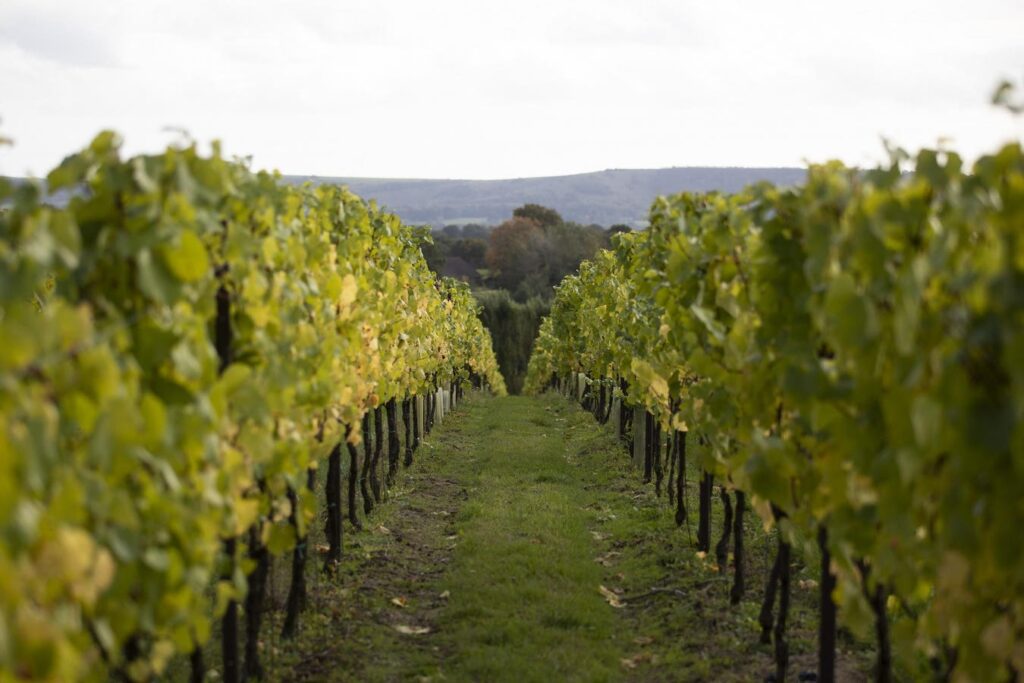Vines stands for Nyetimber Ltd vineyard. In West Chiltington, United Kingdom, on Wednesday, October 7, 2020.
© 2020 Bloomberg Finance LP
For centuries, old world wine regions such as Bordeaux in France or Tuscany in Italy have dominated the global wine market. After half a century of runaway success, even California's Napa Valley is now included in the same conversations.
However, the landscape continues to change. A growing number of emerging wine regions are captivating palates with unique grape varieties, innovative winemaking techniques, and exciting flavours. These regions, often overlooked in the past, now challenge the status quo and offer compelling alternatives for adventurous wine drinkers.
This rise can be attributed to several factors. Climate change plays an important role, as historically marginal areas have become more suitable for grape growing. In addition, advances in viticulture and winemaking allow producers to adapt traditional methods to better suit local conditions and produce wines with a distinct regional character. Furthermore, consumers' increasing interest in exploring new flavors and varieties of grapes is leading to increased demand for (and more investment in) wines from these emerging regions.
These under-the-radar areas offer a variety of styles and experiences. From the high-altitude vineyards of Patagonia in both Chile and Argentina to the cool-climate valleys of New York's Finger Lakes that craft elegant Riesling and Pinot Noir, the possibilities are vast. Countries such as China, where the Ningxia region produces exciting Cabernet blends, and Georgia, often referred to as the “Birthplace of Wine” with its ancient tradition of producing amber wines in clay vessels, are also leaving a mark on the global wine scene.
As these regions continue to develop unique identities, wine lovers can expect a steady stream of exciting discoveries. Below is a summary of some of the most promising regions, exploring the factors driving growth and revealing the distinctive wines they produce.
Classic Cuvee sparkling wine produced by Nyetimber Ltd is poured. In a cup in this order … (+)
© 2020 Bloomberg Finance LP
England
For many casual wine drinkers, England would not be the first place that comes to mind for exceptional sparkling wine. However, a quiet revolution is taking place in the vineyards of the south of the country. Thanks to a combination of factors such as rising temperatures, innovative technologies and dedicated producers, England is rapidly gaining recognition for its world-class sparkling wines. The chalky soils found in many southern regions — especially those similar to the soils of France's unparalleled Champagne-Ardenne region — create ideal conditions for grapes like Chardonnay and Pinot Noir, the traditional backbone of sparkling wine. English sparkling wines are known for their vibrant acidity, delicate floral aromas and refreshing citrus flavours, providing a compelling alternative to their French counterpart, which generally has a softer, more rounded acidity with a richer, creamier texture.
Hailing from the county of Sussex in southern England, Netember has emerged in the past few years as one of the leaders of the English sparkling wine movement. The winery uses traditional methods, such as those used in the Champagne region, to make wines from Chardonnay, Pinot Noir and Pinot Meunier grapes. Nyetimber sparkling wines have received international recognition and awards for their quality wines, from sparkling rosé wines to Blanc de Blancs.
Even within England, there are more hidden gems. Overshadowed by the more established English wine regions, Oxfordshire quietly produces some of the country's most exciting wines. A few hours outside of London, Oxfordshire's climate is well suited to growing grapes thanks to the influence of the Gulf Stream, which brings warm water and moderates the temperature. This means that the grapes can fully ripen while maintaining good acidity, which is important for making high-quality wine.
Hundred Hills Winery was established by Stephen and Fiona Duckett after a careful three-year search for the ideal location for the vineyard. The chalk cliffs of the Stonor Valley were chosen for their resemblance to Champagne, France. The Hundred Hills uses traditional methods to produce a range of sparkling wines, including blanc de blancs, blanc de noirs and rosé. Its wines are praised for their freshness, intensity and elegance, and are served in some of the UK's best Michelin-starred hotels and restaurants.
Bottles of Ao Yun wine are pictured in the “Legrand filles et fils” liquor store in Paris, on … (+)
AFP via Getty Images
China
China's wine industry has seen significant growth in recent years, with new regions emerging alongside existing ones. While Ningxia currently holds the title of China's number one wine producing region, Yunnan Province in the southwest is attracting interest for its unique potential.
Located near the foothills of the Himalayas, Yunnan Province is at the opposite of tropical latitude, creating a cool climate suitable for viticulture. This, combined with diverse microclimates and abundant water sources, has led to the emergence of experimental vineyards and international investment. It is worth noting that French luxury goods giant LVMH has invested in a winery in Yunnan, Ao Yun, showing confidence in the future of the region.
Grapes grow on vines at a vineyard near Ensenada, in the Valle de Guadalupe region of Baja … (+)
© 2016 Bloomberg Finance LP
Mexico
Mexico's reputation as a major center for tequila and mezcal is slowly being challenged by a booming wine industry. Although overshadowed by more established New World producers, Mexico boasts ideal viticultural conditions in certain regions. The country's unique geography, where mountainous regions contrast with coastal plains, creates a diversity of climates. This allows a wider range of grape varieties to be grown than one might expect.
Baja California, and particularly Valle de Guadalupe, has emerged as a front-runner in Mexican wine production. Its Mediterranean climate, with warm days tempered by cool Pacific breezes and proximity to the ocean, is very similar to that of California's Napa Valley. This has proven particularly suitable for red varieties such as Cabernet Sauvignon and Merlot, although experiments with white grapes also look promising.
Outside of Baja, central Mexican regions such as Queretaro with high-altitude vineyards produce sparkling wines and red wines made from Tempranillo, Cabernet Sauvignon, Merlot, Malbec and Syrah grapes.
Inside the tasting room at Modales Wines. Reservations are recommended for tasting and guidance … (+)
Rachel King
United State
Ask most people about wine production in the United States, and they're likely to talk about wines made in the same states—namely California, Oregon, Washington, and maybe even New York for the familiar East Coast North Fork on the Long. The island as well as the Finger Lakes in the north of the state. This fact may surprise some, but there are wineries and vineyards in all 50 states, from rosé blends made on Maui to microgreens produced outside Colonial Williamsburg in Virginia. Even within the most popular regions, there are plenty of surprises, like the cool-climate wines and special sparkling wines of the Finger Lakes.
Since Michigan is home to the Fruit Belt, it should come as no surprise that this region is also great for growing grapes. Located along the eastern shores of Lake Michigan, this region has a thriving wine scene intertwined with its long history of fruit production. This unique microclimate, controlled by the cooling effect of the lake, promotes ideal conditions for grapes along with the region's abundant cherries, apples and berries. Although not as widely known as California or Bordeaux, Michigan wineries are increasingly gaining a reputation for producing high-quality wines with character. Notably, the well-drained, sandy soil of the Lake Michigan Shore AVA, the state's first American viticultural area, has proven particularly suitable for growing cool-climate grape varieties such as Riesling, Pinot Noir and Chardonnay. This grape thrives in moderate temperatures and an extended growing season.
The nearby town of Saugatuck provides a charming and convenient home base for exploring the region's thriving wine scene. This quaint lakeside town has a pedestrian-friendly atmosphere, allowing you to easily wander among the art galleries, shops and restaurants after a day of vineyard hopping. Saugatuck has a large number of inns and vacation rentals, including the new five-star Wickwood Inn, which can arrange tours for its guests to nearby wineries — especially Modales Wines, which produces a wide range of adventurous wines, ranging from pet-friendly And even dry wine. Riesling as well as fruit-based cider. Modales is also located on a stunning estate that hosts a lively indoor tasting room great for small and large groups alike, as well as a covered outdoor patio offering stunning views of the vineyards.
An employee turns bottles at the Artwinry wine company in the city of Bakhmut, eastern Ukraine.
AFP via Getty Images
Ukraine
Ukraine's wine industry has shown unexpected resilience in the face of war, with new wineries springing up even as existing vineyards face devastation and logistical hurdles. Despite these challenges, Ukrainian wines are gaining international recognition for quality and character.
Before the war, the local wine scene was already experiencing a revival, with an emphasis on cool grapes and innovative techniques. While the country boasts a long history of viticulture, Soviet-era policies and the recent war after the Russian invasion have presented unprecedented challenges. (For example, in the late 1980s, the Soviet government implemented a prohibition campaign aimed at reducing alcohol consumption, which led to the destruction of many vineyards and a significant decline in wine production.)
Despite these obstacles, a new generation of passionate winemakers is emerging, especially in the western and central regions.
These regions – including Lviv, Ternopil and Khmelnytskyi – benefit from cool temperatures and abundant rainfall. This climate is ideal for growing aromatic white varieties such as Riesling and Pinot Gris, resulting in wines known for their crisp acidity and bright fruit flavours.
Experimentation is also a hallmark of this new wave of Ukrainian winemakers. Some are exploring the production of amber wines, which feature extended skin contact creating a unique orange color and complex flavors. In addition, there is a growing interest in sparkling wines and even pest-resistant grapes (PIWI), demonstrating a desire to embrace new possibilities.
The future of Ukrainian wine is uncertain, with the ongoing war posing a major threat to vineyards and wineries. However, the dedication and innovation of Ukrainian winemakers has captured the attention of international audiences. With improved accessibility and stability, Ukrainian wine has the potential to gain a broader following and establish the country as an exciting player in the global wine market.


